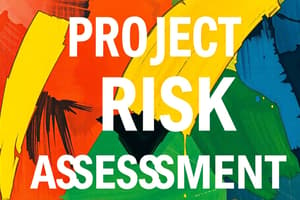Podcast
Questions and Answers
What is a significant disadvantage of qualitative risk analysis?
What is a significant disadvantage of qualitative risk analysis?
- It generates a wide range of ideas quickly.
- It measures risks objectively.
- It requires multiple experts for analysis.
- It can be dominated by certain individuals. (correct)
What does the Expected Monetary Value (EMV) calculation involve?
What does the Expected Monetary Value (EMV) calculation involve?
- Multiplying the probability of an event by its monetary impact. (correct)
- Assessing risk based on stakeholder opinions.
- Counting the number of risks identified in a project.
- Summing total costs of all risks.
Which of the following best describes sensitivity analysis?
Which of the following best describes sensitivity analysis?
- A strategy for categorizing weaknesses and threats.
- A method for involving stakeholders in risk identification.
- A technique to measure average outcomes of risks.
- A process to determine the risks with the greatest potential impact. (correct)
What is a major advantage of using brainstorming in qualitative risk analysis?
What is a major advantage of using brainstorming in qualitative risk analysis?
Which of the following is NOT a type of probability distribution used in quantitative risk analysis?
Which of the following is NOT a type of probability distribution used in quantitative risk analysis?
Which component typically represents internal risk factors in a SWOT analysis?
Which component typically represents internal risk factors in a SWOT analysis?
What does quantitative risk analysis primarily focus on?
What does quantitative risk analysis primarily focus on?
What is a characteristic limitation of qualitative risk analysis?
What is a characteristic limitation of qualitative risk analysis?
What is the primary purpose of risk analysis in project management?
What is the primary purpose of risk analysis in project management?
In qualitative risk analysis, what is the significance of using descriptive scales like High, Medium, and Low?
In qualitative risk analysis, what is the significance of using descriptive scales like High, Medium, and Low?
Which of the following describes the probability in the context of risk analysis?
Which of the following describes the probability in the context of risk analysis?
Why is risk data quality assessment crucial in qualitative risk analysis?
Why is risk data quality assessment crucial in qualitative risk analysis?
What does the probability/impact matrix help in risk management?
What does the probability/impact matrix help in risk management?
Which technique in qualitative risk analysis involves the expertise of knowledgeable individuals?
Which technique in qualitative risk analysis involves the expertise of knowledgeable individuals?
Which factor is NOT a concern in risk data quality assessment?
Which factor is NOT a concern in risk data quality assessment?
What is one of the main outcomes of prioritizing risks in qualitative risk analysis?
What is one of the main outcomes of prioritizing risks in qualitative risk analysis?
Flashcards
Risk Analysis
Risk Analysis
The process of evaluating identified risks to determine their likelihood of occurrence and potential impact on project goals.
Qualitative Risk Analysis
Qualitative Risk Analysis
A subjective assessment of risks using descriptive scales to prioritize them for further analysis or action.
Probability (Risk Analysis)
Probability (Risk Analysis)
The likelihood of a risk event happening.
Impact (Risk Analysis)
Impact (Risk Analysis)
Signup and view all the flashcards
Probability/Impact Matrix
Probability/Impact Matrix
Signup and view all the flashcards
Risk Data Quality Assessment
Risk Data Quality Assessment
Signup and view all the flashcards
Judgment (Qualitative Risk Analysis)
Judgment (Qualitative Risk Analysis)
Signup and view all the flashcards
Brainstorming (Qualitative Risk Analysis)
Brainstorming (Qualitative Risk Analysis)
Signup and view all the flashcards
Brainstorming (Risk Analysis)
Brainstorming (Risk Analysis)
Signup and view all the flashcards
SWOT Analysis (Risk Analysis)
SWOT Analysis (Risk Analysis)
Signup and view all the flashcards
Weaknesses (Risk Analysis)
Weaknesses (Risk Analysis)
Signup and view all the flashcards
Threats (Risk Analysis)
Threats (Risk Analysis)
Signup and view all the flashcards
Expected Monetary Value (EMV)
Expected Monetary Value (EMV)
Signup and view all the flashcards
Probability Distributions
Probability Distributions
Signup and view all the flashcards
Sensitivity Analysis
Sensitivity Analysis
Signup and view all the flashcards
Study Notes
Risk Analysis
- Risk analysis is the process of evaluating identified risks to determine their likelihood of occurring and their potential impact on project objectives.
Purpose
- Prioritization: Focus on the most significant risks.
- Decision-Making: Inform decisions about risk responses.
- Resource Allocation: Allocate resources efficiently.
- Communication: Facilitate clear communication with stakeholders.
Qualitative Risk Analysis
- Describing risks: A process of prioritizing risks for further analysis based on probability of occurrence and impact using descriptive scales (e.g., High, Medium, Low).
- Focus: Subjective assessment based on expert judgment, experience, and readily available data.
- Key considerations when determining risk data quality include accuracy, reliability, completeness, and timeliness of data.
Probability and Impact
- Probability: The likelihood that a risk event will occur, using terms like Rare, Unlikely, Possible, Likely, and Almost Certain.
tImpac: The effect that a risk event will have on project objectives if it happens, with terms like Negligible, Minor, Moderate, Major, Critical, Catastrophic.
Probability/Impact Matrix
- A matrix combines probability and impact of risks to assign a risk score or categorize risks.
- The matrix is used to rank risks based on their probability and impact scores.
Risk Data Quality Assessment - Evaluating the reliability and accuracy of the data used for risk analysis.
Why Risk Data Quality Assessment is important?
Poor quality risk can lead to:
- Incorrect risk prioritization
- Ineffective risk responses
- Wasted resources
Unrealistic risk assessments
Factors of Risk Data Quality Assessment
- Data Accuracy
- Data Reliability
- Data Completeness
- Data Timeliness
Other Qualitative Techniques
- Judgment - Relying on the knowledge and experience of experts to assess risks
- Brainstorming- A group technique for generating a list of potential risks.
- SWOT Analysis- Identifying risks from weaknesses and threats in a SWOT analysis.
Quantitative Risk Analysis
- Measuring risk: A process of numerically analyzing the probability and impact of risks to determine their overall effect on project objectives.
- Focus: Objective measurement using numerical data and statistical techniques.
Expected Monetary Value (EMV): The average outcome of a risk event, calculated by multiplying the probability of the event by its monetary value. Formula: EMV = Probability * Impact (in monetary terms)
Probability Distributions: Mathematical functions that describe the likelihood of different outcomes, representing uncertainty more realistically (e.g., Triangular, Normal, Uniform, Beta Distributions).
Sensitivity Analysis: A technique determining the most significant risks affecting the project.
Monte Carlo Simulation: A technique simulating the effect of multiple risks on project outcomes using computer-generated random numbers.
Decision Tree Analysis: A graphical representation of decision options and their consequences.
Inputs and Outputs of Risk Analysis
Inputs to Risk Analysis
- Risk Register: The primary input, containing identified risks and descriptions.
- Project Scope Statement: Defines the project boundaries for risk analysis.
- Project Management Plan: Provides context and information.
- Organizational Process Assets: Policies, procedures, and historical data.
Outputs:
- Prioritized Risk List: Risks ranked by their overall risk score or category.
- Risk Report: A document summarizing the results of risk analysis, including risk descriptions, probabilities, impacts, and response recommendations.
Studying That Suits You
Use AI to generate personalized quizzes and flashcards to suit your learning preferences.





